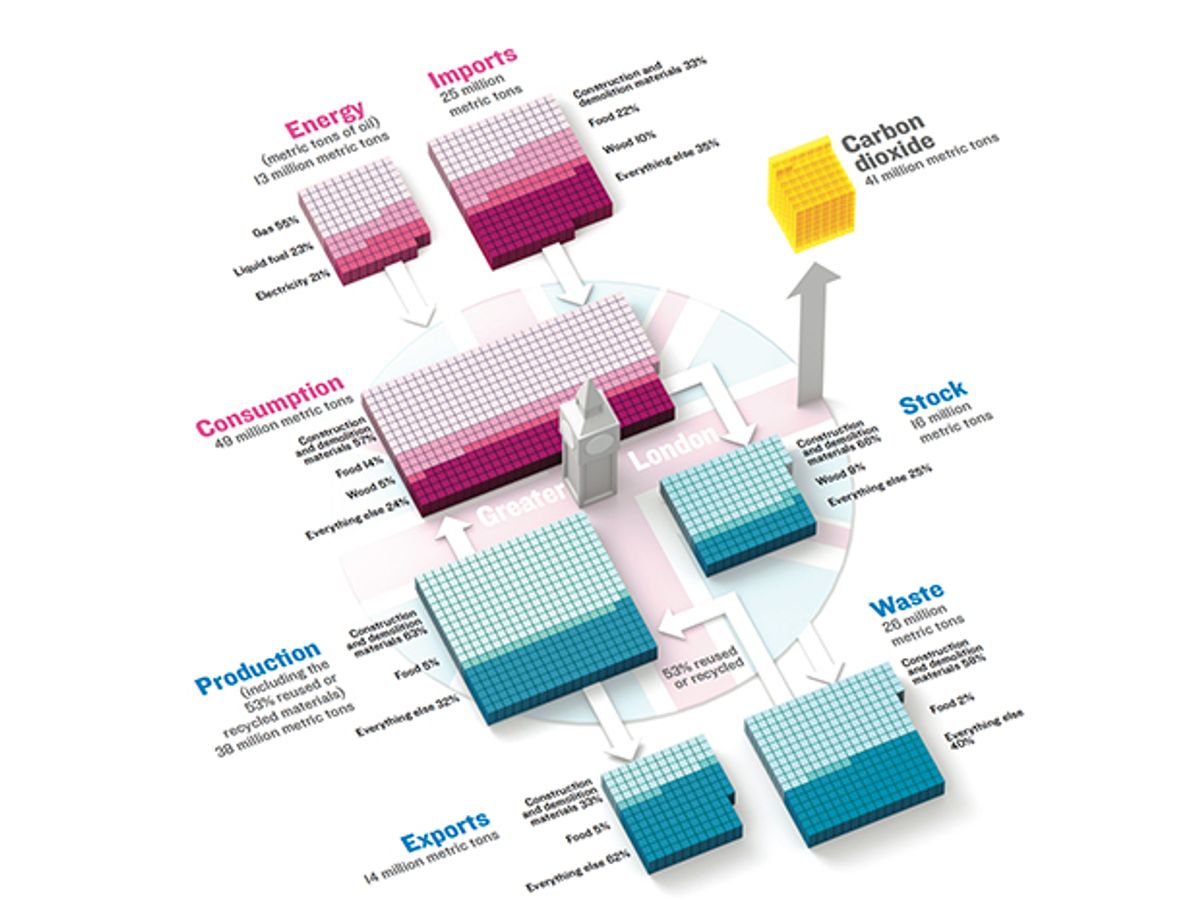How to Measure a City's Metabolism
Taking stock of London's appetites

Greater London, like all metropolitan areas, is a living thing. Each year it eats—7 million metric tons of food. It drinks—94 million liters of bottled water alone. It breathes—giving off 41 million metric tons of carbon dioxide. It excretes—generating 26 million metric tons of garbage. It builds itself up with 28million metric tons of cement, glass, and other construction materials. And it falls apart, generating 15 million metric tons of debris from demolished buildings.
But very little of what feeds and builds London comes from the city itself, and even less of the waste stays there. Instead, in order to feed, clothe, power, and build today’s major metropolises you need the product of thousands of square kilometers outside the city limits. And you need thousands of square kilometers more to absorb the discards.
Just how much land is commandeered to support cities, nations, and their inhabitants is measured using what sustainability wonks call ecological-footprint analysis. Invented two decades ago by William Rees, a professor of community and regional planning at the University of British Columbia, and developed by his former student Mathis Wackernagel, now executive director of the nonprofit Global Footprint Network (GFN), in Oakland, Calif., ecological-footprint analysis looks at the flow of materials and energy into and out of an area. It then determines how much productive land and water is needed to supply the renewable resources involved (including the energy to process them) and to deal with the waste generated (including the biomass needed to sequester the carbon dioxide given off).
Because the productivity and utility of land varies greatly around the world, ecological-footprint analysts came up with a leveler called the global hectare, a stretch of land with average ability to produce resources and process waste. According to the Living Planet Report 2006 by the GFN, World Wildlife Fund International, and the Zoological Society of London, each person on Earth consumed the renewable resources of 2.2 such global hectares in 2003. Unfortunately, there are only 1.8 global hectares per person available. “’We are in overshoot,” Rees says.
Although the GFN publishes a country-by-country analysis every two years, an accurate footprint of cities is hard to come by. The United Nations provides a standard set of data for each country regarding the import, production, and export of key goods including corn, petroleum, and metals. But to get a totally reliable data set for a city, researchers would have to “know the contents of every truck going in and out for years,” Rees says. Most city estimates instead start with the national footprint and then make some corrections for population, transportation infrastructure, wealth, and some other factors.
Using that type of crude adjustment for Tokyo, according to Rees, results in the conclusion that the capital city requires 60 percent more productive land than exists in all of Japan. Tokyo survives only because it can count on the ecologies of other countries. Cities are “entirely dependent on cheap energy and absolutely secure lines of communication and transportation,” Rees says. “In the absence of that, you’ve got a huge problem.”
Urbanites, even in poor cities, tend to have the money to consume more than their rural brethren, Rees says, so cities tend to have outsized ecological footprints. However, he notes, public transportation, efficient heating, streamlined services, and other things that are economical in cities but not elsewhere can ease urbanization’s impact on the environment. “Cities do enable—if we organize them properly—the displacement of private cars in favor of public transportation, cogeneration, recycling, and remanufacturing,” he says. “In general, high-income cities increase the ecological footprint because of rising incomes and rising consumption, but we could—through intervention in the economy, appropriate planning, densification, and tax policies—turn it around. But so far we are choosing not to do so.”
The number of urbanites has tripled since the early 1960s and now represents half of the world’s 6.5 billion population, which approximately doubled during that time. Meanwhile, our global footprint has more than doubled since the early 1960s, when it took up half the planet’s renewable resources. It now exceeds the Earth’s resources by about 25 percent, meaning that we are degrading the planet’s ability to support us. If you think of those resources as a bank account, we are no longer living only off the interest. We are spending capital.
So far, the largest urban area to have its footprint measured systematically is London. The results appeared in a report titled City Limits, released in 2002. London doesn’t qualify as a mega city but, with a living and working population of more than 7.4 million, it’s the largest city in the European Union. Although the authors, at the Oxford-based firm Best Foot Forward, didn’t know the contents of every London-bound truck, they were able to gather and analyze a surprisingly rich set of data. They found that London’s ecological footprint was 49 million global hectares—293times its geographical area and equivalent to two United Kingdoms. On a per-person basis, Londoners took up 6.6global hectares, putting them on a par with the Swiss and making them twice as frugal as the average American, but still more than three times as voracious as what the Earth can provide.
To see all of Spectrum’s special report on The Megacity, including online extras and audio and video exclusives, go to /moremegacity.


